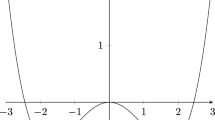Abstract
This paper is concerned with the stability of multiclass queueing networks of 2 stations and4 buffers under the longest queue first served discipline (LQFS). For this network, the service priority of a customer is determined by the length of the queue that customer resides in at that time. The main result includes two parts. Firstly, the corresponding fluid model is established, and then it is shown that the queueing networks under LQFS are stable whenever the traffic intensity is strictly less than one for each station.
Similar content being viewed by others
References
Yao D D, Stochastic Modeling and Analysis of Manufacturing Systems, Springer, New York, 1994.
Bramson M, Instability of FIFO queueing networks, Annals of Applied Probability, 1994, 4: 414–431.
Lu S H and Kumar P R, Distributed sheduling based on due dates and buffer priorities, IEEE Trans. Autom. Control, 1991, 36: 1406–1416.
Rybko S and Stolyar A, Ergodicity of stochastic processes that discribe the functioning of open queueing networks, Problem of Information Transmission, 1992, 28: 3–26.
Seidman T I, First come, first served can be unstable! IEEE Trans. Automat. Control, 1994, 39: 2166–2171.
Bramson M, Convergence to equilibria for fluid models of FIFO queueing networks, Queueing Systems, 1996, 22: 5–45.
Bramson M, Convergence to equilibria for fluid models of head-of-the-line proportional process sharing queueing networks, Queueing Systems, 1996, 23: 1–26.
Dai J G, On the positive Harris recurrence for multiclass queueing networks, Annals of Applied Probability, 1995, 5: 49–77.
Dai J G and Lin W Q, Maximum pressure policies in stochastic processing networks, Operations Research, 2005, 53: 197–218.
Dai J G and Weiss G, Stability and instability of fluid models for re-entrant lines, Mathematics of Operations Research, 1996, 21: 115–134.
Stolyar A, Maxweight scheduling in a generalized switch: State space collapse and workload minimization in heavy traffic, The Annals of Applied Probability, 2004, 14: 1–53.
Kumar P R and Seidman T I, Dynamic instabilities and stabilization methods in distributed real-time scheduling of manufacturing systems, IEEE Transactions on Automatic Control, 1990, 35: 289–298.
Author information
Authors and Affiliations
Corresponding author
Additional information
This research was supported by the National Natural Science Foundation of China under Grant No. 11101050.
This paper was recommended for publication by Editor WANG Shouyang.
Rights and permissions
About this article
Cite this article
Yang, J., Hu, Y. Stability of Kumar-Seidman networks under longest queue first policy. J Syst Sci Complex 28, 848–856 (2015). https://doi.org/10.1007/s11424-015-3084-6
Received:
Revised:
Published:
Issue Date:
DOI: https://doi.org/10.1007/s11424-015-3084-6



